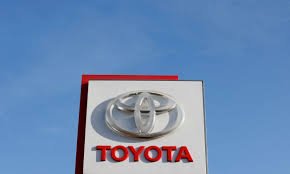The imposition of U.S. tariffs on imported vehicles is expected to accelerate Toyota Motor’s competitive edge over other Japanese automakers. Despite the implementation of a 25% levy by former President Donald Trump on foreign auto imports, Toyota Motor Corporation (Ticker: 7203.T) has managed to maintain a relatively stable pricing strategy in the U.S. market. While other manufacturers from Japan are being strained by thinner profit margins, Toyota’s resilience is likely to be rewarded with increased market dominance.
Toyota Tariff Advantage Reflected in Minimal Price Hikes
It has been revealed that Toyota’s prices in the U.S. will be increased only marginally. A recent announcement indicated that prices for select models will be raised by an average of just $270. This change, part of a routine pricing review, equates to a mere 0.7% hike based on the average price of a Toyota vehicle sold in North America, as calculated by Visible Alpha. In contrast, other automakers may be compelled to push through significantly higher increases due to their tighter margins and less diversified cost structures.
By choosing not to pass the full weight of the tariffs onto consumers, Toyota has demonstrated strategic restraint. This decision will likely fortify its brand loyalty and help preserve, or even grow, its market share in North America—especially as consumers become more price-sensitive in an inflationary economic environment.
Japan Inc Faces Mounting Pressure
The broader group of Japanese carmakers, collectively known as “Japan Inc,” is expected to feel mounting pressure as the tariffs remain in effect. The Toyota tariff advantage has become increasingly evident, as the company, with its $222 billion valuation and extensive local production footprint, remains better positioned than smaller rivals such as Mazda, Subaru, and Mitsubishi, which operate with far less margin flexibility.
These companies rely more heavily on exports and have fewer U.S.-based manufacturing plants. As a result, they are more vulnerable to the impact of the import tariffs and less capable of absorbing the additional costs. Many of them could be forced into either raising prices substantially or reducing their profit margins—both of which would weaken their competitive position in the United States.
Toyota’s U.S. Production Shield
A significant buffer against the full impact of the tariffs has been provided by Toyota’s substantial investment in U.S.-based production. With manufacturing plants strategically located across the country—including in states like Kentucky, Texas, and Mississippi—Toyota has ensured that a large portion of its vehicles sold in the U.S. are made domestically. This operational strategy has reduced exposure to tariff-related costs and allowed for pricing stability that competitors may find difficult to match.
The company’s long-term commitment to U.S. manufacturing is now being rewarded. Not only are tariff impacts minimized, but additional goodwill is also being earned from both consumers and policymakers for supporting domestic jobs.
Slim Margins Leave Rivals Exposed
The profit margins enjoyed by Toyota dwarf those of several rival automakers. Due to greater efficiency, scale, and diversification, Toyota has consistently outperformed its Japanese peers in terms of financial strength. Smaller manufacturers such as Suzuki and Isuzu, who may lack the scale to distribute increased costs across a large volume of units, are expected to suffer a disproportionate share of the fallout.
If Tokyo fails to negotiate a reprieve or exemption from the tariffs, it is likely that these companies will lose significant market share. Dealers might also reduce orders for their models, and U.S. consumers may shift towards alternatives that are less affected by price hikes.
A Shift in Competitive Dynamics
The competitive dynamics of the automotive industry in the U.S. are being reshaped by these policy changes. The tariffs are not only influencing pricing strategies but are also redefining supply chain logistics and production planning for global automakers. Toyota’s foresight in localizing its operations is now seen as a strategic masterstroke, while rivals who maintained heavier export dependence are now being penalized.
The disruption caused by tariffs is expected to accelerate consolidation trends within the industry, with dominant players like Toyota further strengthening their position. Over time, smaller firms may either need to seek alliances or consider mergers to survive in the new tariff-laden environment.
Limited Room to Maneuver for Other Japanese Brands
While Toyota’s success story is underpinned by robust infrastructure and substantial financial resources, other Japanese automakers are finding their strategic options limited. Rapid adjustments to production or supply chains are not feasible for most companies due to the capital-intensive nature of the automotive industry.
Furthermore, consumer demand in the U.S. remains volatile, and absorbing additional production costs without assured volume can prove risky. In many cases, these manufacturers might resort to trimming feature sets, reducing dealer incentives, or delaying new launches—tactics that could adversely affect their brand equity in the long term.
Policy Decisions in Focus
Attention has now shifted to Tokyo’s diplomatic efforts to secure an exemption from the tariffs. The Japanese government is under pressure to negotiate favorable trade terms that could shield its automakers. However, the likelihood of securing a rollback or special treatment remains uncertain, especially amidst heightened protectionist sentiment in the U.S.
Even if trade talks are resumed under a new U.S. administration, the damage to competitive balance may already be done. Toyota’s entrenched position and relatively tariff-proof business model have set a new benchmark for the industry.
Conclusion
In conclusion, Toyota Motor Corporation is poised to extend its dominance over Japan Inc, thanks in large part to its strategic pricing decisions and robust local manufacturing presence. While U.S. import tariffs are squeezing many global automakers, Toyota has displayed a unique ability to navigate the disruption with minimal impact.
Unless meaningful policy changes are introduced or a diplomatic resolution is achieved, other Japanese automakers may continue to struggle in maintaining their market positions. In the evolving landscape of international trade and automotive production, Toyota’s foresight and financial muscle are expected to ensure it remains the clear winner.


